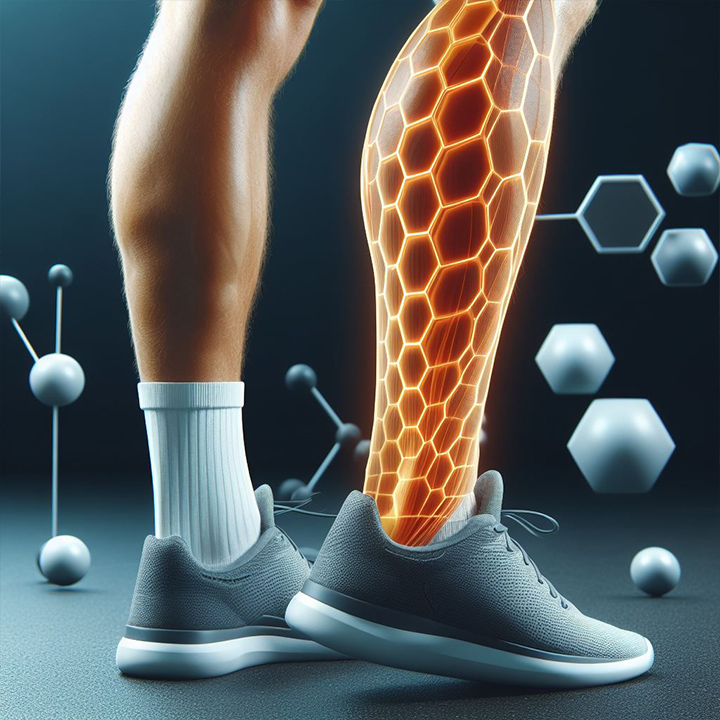
Unlocking The Fascia of Athletic Performance:
The Power of Fascia Training in Soccer
In the world of soccer, every fraction of a second and every degree of flexibility can make a games difference. Athletes are constantly seeking new ways to improve their performance and stay injury-free. One method gaining increasing attention is fascia training. In this comprehensive guide, we’ll explore the world of fascia. Investigating its relevance in soccer and provide you with valuable insights into how fascia training can elevate your game to new heights.
Understanding Fascia
Fascia, often referred to as the body’s “hidden web,” is a remarkable connective tissue that surrounds and supports our muscles, organs, and bones. It plays a pivotal role in maintaining structural integrity, enabling smooth movement, and transmitting force throughout the body. To understand the significance of fascia in soccer, it’s essential to grasp the basics of this intricate network.
Fascia can be categorized into different types based on its location and function. Superficial fascia lies just beneath the skin, deep fascia surrounds muscles and muscle groups, and visceral fascia surrounds internal organs. This is a multifaceted system. When this system functions optimally, it can contribute to agility, flexibility, and resilience.

Fascia Training Benefits for Soccer Players
So, how can fascia training benefit soccer players? These benefits are the utility tools of the body that enable the performance of the athlete to operate at a higher function when trained. Let’s explore the top 5 key advantages.
Improved Speed and Power
One of the greatest advantages you can gain from fascia exercises is improved speed. As you work the muscles in your body, they will respond by providing you with more power and agility. This is a wonderful combination that will take your performance to the next level.
Flexibility and Mobility
Soccer demands a wide range of motion. Kicking and sprinting to sudden changes in direction take a toll on the body. Flexible fascia ensures that the muscles and joints can move freely, allowing players to execute these movements with precision and efficiency. Fascia training exercises that improve flexibility can significantly enhance a player’s performance through a wider range of motion.
Injury Prevention
Injury prevention is a top priority for any athlete. A well-conditioned fascia system can reduce the risk of common soccer injuries. Muscle strains and tears are the most common. By strengthening and conditioning the fascia, players can better withstand the physical demands of the game and the toll it takes on the body.
Elasticity
Explosive movements, such as sprinting to reach the ball or making quick turns, require elasticity in the fascia. Think of it as a natural spring that stores and releases energy efficiently. Fascia training will aim to enhance this elasticity. This will provide players with an edge in speed and power.
Recovery
The demands of soccer can take a toll on the body. Post-match or post-training recovery is crucial for maintaining peak performance throughout the season. Fascia training techniques can aid in recovery by reducing muscle soreness and improving overall healing processes.

Fascia Training Techniques
To unlock the benefits of fascia training, soccer players can incorporate a variety of techniques and exercises into their routines. Here are some effective methods:
Dynamic Stretching
Dynamic stretching exercises that target the fascia can improve flexibility and range of motion. Incorporating movements like leg swings and hip circles into warm-up routines can prepare the fascia for the demands of the game.
Myofascial Release
Myofascial release is often performed using foam rollers or massage balls. This can alleviate tension and knots in the fascia. This technique helps improve tissue mobility and blood flow. This makes it an excellent choice for recovery and injury prevention.
Strength Training
Strength training exercises that engage multiple muscle groups can indirectly benefit the fascia. Exercises like squats, deadlifts, and kettlebell swings promote functional strength and enhance fascial integrity.
Balance and Coordination Drills
Balance and coordination are essential for soccer players. Specific drills can challenge the fascial system, enhancing proprioception and stability on the field.
Injury Prevention and Rehabilitation
Imagine a scenario where a soccer player experiences a common injury like a hamstring strain. Fascia training can play a vital role in both preventing and rehabilitating such injuries. Let’s take a closer look at how fascia training can contribute to injury prevention and recovery:
Preventing Common Soccer Injuries
Explore how targeted fascia training can reduce the risk of injuries like hamstring strains, Achilles tendonitis, and groin pulls. We’ll provide insights into specific exercises and routines that can strengthen the fascia and surrounding musculature to ward off these issues.
Rehabilitation Techniques
In the unfortunate event of an injury, fascia training can aid in the rehabilitation process. We’ll discuss how controlled, progressive fascia exercises can facilitate healing and expedite the return to the field.

Success Stories
The impact of fascia training on soccer players cannot be understated. Here are some compelling case studies and success stories that highlight the tangible benefits of incorporating fascia training into your soccer regimen.
Several elite professional soccer athletes and teams are known to incorporate fascia training or related techniques into their routines. The specific methods and extent to which individual athletes use fascia training may vary. Here are a few notable examples.
Cristiano Ronaldo: Cristiano Ronaldo is renowned for his commitment to maintaining peak physical condition throughout his career. He has reportedly embraced fascia training, among other cutting-edge techniques. His goal is to enhance his flexibility, speed, and overall performance.
Lionel Messi: Messi is another soccer superstar known for his dedication to physical fitness. While specific details of his training regimen might not always be publicly disclosed, it’s likely that he and his support team have explored various training methods, including fascia-related techniques. Some of them seem to be clear after watching his exercise regime and recovery methods.
Neymar Jr.: Neymar, one of the world’s top forwards. He is also known to incorporate innovative training methods into his routine. While not all details of his training are publicly available, it’s common for elite athletes like Neymar to explore diverse training techniques, including those that address fascia health. Simple videos of Neymar juggling barefooted are tell-tale signs of his progressive concepts of body development and recovery care.
It’s important to note that the details of athletes’ training routines are often closely guarded secrets or may evolve over time. The popularity and awareness of fascia training will likely continue to grow in the world of professional soccer and other sports alike. To get the most up-to-date information on which athletes are utilizing fascia training in their routines, I recommend checking recent sports news, interviews, and reports from credible sources in the sports and fitness industry.
Team Success through Fascia Training
Many professional soccer clubs have integrated fascia training and related methods into their team training programs. Clubs like FC Barcelona, Manchester City, and Bayern Munich invest in cutting-edge sports science and conditioning, which may include fascia-focused techniques to keep their players in top shape.
National teams competing in major tournaments, such as the FIFA World Cup and the UEFA European Championship, often employ sports scientists and physiotherapists who are well-versed in the latest training methods, including fascia training.
The Role of Professional Guidance
Fascia training offers significant advantages. It’s essential to approach training with knowledge and care. Working with professionals who understand the nuances of fascia training is crucial for optimal results.
They provide customized training plans. They discuss the importance of personalized plans tailored to an individual player’s needs and goals. Professional guidance ensures that the fascia training program aligns with a player’s specific strengths and weaknesses.
The other major benefit is the assessment and monitoring you will receive. They highlight the role of ongoing assessment and monitoring by trained coaches or physical therapists. These assessments can identify areas of improvement and guide adjustments to the training regimen. Some adjustments may even be made to reduce the intensity of a session to prevent overuse.

Top 5 Fascia Training Exercises for Soccer Players
- Foam rolling: Foam rolling is a self-massage technique that can be used to release tension and improve the flexibility of the fascia.
- Dynamic stretches: Dynamic stretches are active stretches that prepare the body for movement. They can help to increase the range of motion and flexibility of the fascia.
- Plyometrics: Plyometrics are explosive exercises that help to develop power and speed. They can also help to improve the function of the fascia.
- Yoga and Pilates: Yoga and Pilates are both forms of exercise that focus on flexibility, balance, and core strength. They can also be beneficial for fascia training.
Sample Fascia Training Routine
Here is a sample fascia training routine that can be used by soccer players:
Warm-up
5 minutes of light cardio, such as jogging or jumping jacks
5 minutes of dynamic stretches, such as leg swings, arm circles, and torso twists
Foam rolls the quadriceps, hamstrings, calves, glutes, and IT bands for 30-60 seconds each.
Perform dynamic stretches, such as leg swings, arm circles, and torso twists.
Perform plyometric exercises, such as box jumps, depth jumps, and clap push-ups.
Perform yoga poses, such as downward-facing dog, pigeon pose, and warrior pose. Or perform Pilates exercises, such as the roll-up, the hundred, and the double leg stretch.
Cool-down
5 minutes of light cardio
- 5 Start slowly and gradually increase the intensity and duration of the training over time.
- Listen to your body and don’t push yourself too hard.
- Warm up before doing fascia training exercises and cool down afterwards.
- Use a foam roller or other massage tools to release tension and improve the flexibility of the fascia.
- Perform dynamic stretches to increase your range of motion and prepare your body for movement.
- Incorporate plyometric exercises into your routine to develop power and speed.
- Practice yoga and Pilates to improve flexibility, balance, and core strength.
- Fascia Training Exercises for Injury Prevention
- Foam rolling the quadriceps, hamstrings, calves, glutes, and IT bands.
- Performing dynamic stretches, such as leg swings, arm circles, and torso twists.
- Performing plyometric exercises, such as box jumps, depth jumps, and clap push-ups.
- Performing yoga poses, such as downward-facing dog, pigeon pose, and warrior pose. Performing Pilates exercises, such as the roll-up, the hundred, and the double leg stretch.
- Fascia training can help to reduce the risk of injuries in soccer players by improving the flexibility and strength of the fascia. This can help to reduce the risk of strains, sprains, and other injuries.

Here are some great tips to get started
Fascia training can also improve speed, power, agility, and other performance-related factors in soccer players. This is because fascia plays an important role in coordinating movement and generating force.
Fascia training for performance enhancement:
Foam rolling the quadriceps, hamstrings, calves, glutes, and IT bands.
Performing dynamic stretches, such as leg swings, arm circles, and torso twists.
Performing plyometric exercises, such as box jumps, depth jumps, and clap push-ups.
Performing yoga poses, such as downward-facing dog, pigeon pose, and warrior pose. Or, performing Pilates exercises, such as the roll-up, the hundred, and the double leg stretch.
In closing, fascia training represents an exciting frontier in soccer conditioning. By understanding the role of fascia in the body and incorporating targeted fascia training techniques, soccer players can experience improved flexibility, injury prevention, and overall performance. Whether you’re a professional athlete or a weekend warrior, unlocking the potential of your fascia can be a game-changer.
By embracing fascia training and seeking professional guidance, you can set yourself on a path to soccer success that’s underpinned by a strong, resilient, and agile fascial system.

